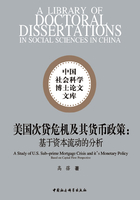
ABSTRACT
The financial turmoil triggered by U. S. sub-prime crisis in 2008 has affected the global economy. The scope of impact, as well as the breadth of extent is beyond expectation. Current studies about the origins of the crisis have been focused on the absence of strict regulation, the policy failure, underestimation of risk and others as well. That is to say, the sub-prime crisis had not occurred endogenously, but exogenously. But the problem is, if it happened exogenously, why it occurred repeatedly? Even if the policy responses of the government are considered prompt and appropriate.
Combining theoretical and empirical studies, this book analyzes the relationship between capital flow, sub-prime mortgage crisis and U. S. monetary policy. It shows that the mechanism of the sub-prime crisis is not evolved endog-enously, but exogenously. This book also shows how monetary policy can affect asset prices and then the real economy. Specifically, we have analyzed that 1. How Alan Greenspan's monetary policies lead to asset price bubbles,2. The conditions of the bubble burst,3. How they affect the financial markets and global economy,4. How the subprime mortgage and derivatives play in the crisis. Besides, this book uses numerical simulation and empirical studies to analyze the Federal Reserve's monetary policy rules over the past decade. Furthermore, we analyze the causes of large capital inflows, the sources of capital, and the relationship between capital inflows and the formation of the monetary rule in the U. S. A.
The main conclusions of this book are summarized as follows:
1.The relationship between the capital inflow and the crisis is that asymmetric monetary system leads the large capital inflows into U. S. mainly in the treasury security market. Huge foreign capitals affect the yields of long-term bonds in the U. S. and it then affect the federal funds rate through the term structure of interest rates. The federal funds rate subsequently affects housing prices significantly. So, persistent low federal funds rate is the main reason for the formation of the real estate bubble and bursting of the bubble is the direct cause of the crisis, and the subprime mortgage and derivatives resulted in the crisis'impact wide and huge. Due to the fact that federal funds rate is influenced by GDP, CPI and capital inflows, so we believe that the crisis is endogenously rooted within the existing economic system.
2.The bursting of the real estate bubble is the fuse of the crisis. As the housing market closely related to the morgage, the funds of real estate rely heavily on bank credit. Therefore, the balance sheet channel is the relative important transmission channel and plays a very important role in the process of crisis transmission. Generally, for the banking is an important financial intermediary, leverage effect in real estate will further stimulate the economic prosperity when asset prices rise; on the contrary, when asset prices fall, leverage effect of banking will magnify the crisis.
3.Based on the Fed's monetary policy rules over the past decade, this book finds that the looser monetary policy is a passive reaction to large capital inflow. Capital inflow is the potential cause of crisis through the impact of monetary policy. If the Asian financial crisis and China's Yuan revaluation are excluded from our sample, the federal funds rate simulation of Taylor rule with capital inflows and the actual federal funds rate can fit well in 1998-2005. And this period is precisely the period that former Federal Reserve Chairman Alan Greenspan described as a mystery. So, adding the factor of capital inflows could explain why the long-term rates fluctuations do not follow the short-term interest rates.
4.Confronted with the rest the world, the U. S. is no more a big-enough country. Capital flows will have real effects on domestic economy. Although the dollar standard make the U. S. government do not have to worry about that persistent current account deficit may trigger crisis, huge capital inflows do seriously affect the term structure of interest rates and might dampen the effect of monetary policy on the interest rates. This conclusion proved again that the current international monetary system is irrational, not only for the non-reserve countries, but also for the reserve countries like the U. S.
5.Regarding the Taylor rule failed to explain the Fed's interest policy, this book claims that capital inflows and the sources of capital leads to the inevitable result under the current monetary system. It has something to do with the“original sin”of debtor countries or“high savings dilemma”of creditor countries. That is to say, this crisis is the result of self-evolving under current economic structure. The asymmetry of current monetary system is the origins of the crisis, and overexpansion of financial derivatives and lagging of financial supervision enhance the danger of the crisis. Therefore, the reform of international monetary system must go ahead. It should be done both from the long term and the short term perspectives. In addition, the reform should take into account the developing countries'or the Asia countries'(such as China)factor. Because of the rising role of China in global economy, the reform needs to take the development of China economy and RMB internationalization into account.
Key Words: Sub-prime Mortgage Loan Crisis; Transmission of Monetary Policy; Taylor Rule; Reform of International Monetary System